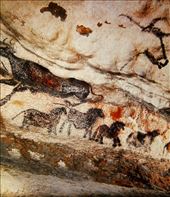MONTIGNAC ISN’T FAR FROM ST. MARTIN-DE-VERS as the crow flies but it is 85 kilometers by winding country roads. I suspect our GPS, Sir Clive, may have thrown in a twist and turn or two just to be cute. We were in this area four years ago to visit the prehistoric cave art at Peche-Merle. We returned this time for the “real deal,” Lascaux. Actually it is the ersatz “real deal,” Lascaux II, a true-to-life replica of the original that took twelve years to complete.

"We have invented nothing."
My favorite artists are the Impressionists — Monet, Renoir, Degas and that bunch — who developed a new way of not only painting but of looking at the world. The real pioneers of art, however, are the Cro-Magnon painters whose canvases were the cave walls and ceilings in the Dordogne and who painted by reindeer fat lamps much like Michelangelo used votive candles on the Sistine Chapel to which their work has been compared. It’s said that Picasso, upon seeing the 17,000 year old paintings in 1940 exclaimed, “We have invented nothing.”


Horses (from photo) Auroch (from photo)
The paintings at Lascaux took the world by storm when they were opened to the public in 1948. By 1955 Lascaux had more than twelve hundred visitors a day and, unfortunately, they all breathed. The heat, humidity, carbon dioxide and bacteria caused so much damage to the paintings that the cave was closed in 1963. Lascaux II, a replica of the Great Hall of the Bulls and the Painted Gallery, located 200 meters away from the original, was opened in 1983.

Polychrome bison, Lascaux II (from photo)
We also visited the nearby Grotte de Rouffignac, where an electric train trundles visitors deep into the cave to see the actual work done by the pre-historic artists — marching mammoths, sturdy bisons, wooly rhinos and herds of horses. I could almost imagine two Cro-Magnons staring, arms folded across their chests saying, “I think a painting of a mammoth should look like a mammoth!” Surely they weren’t disappointed.

Mammoth (Rouffignac)